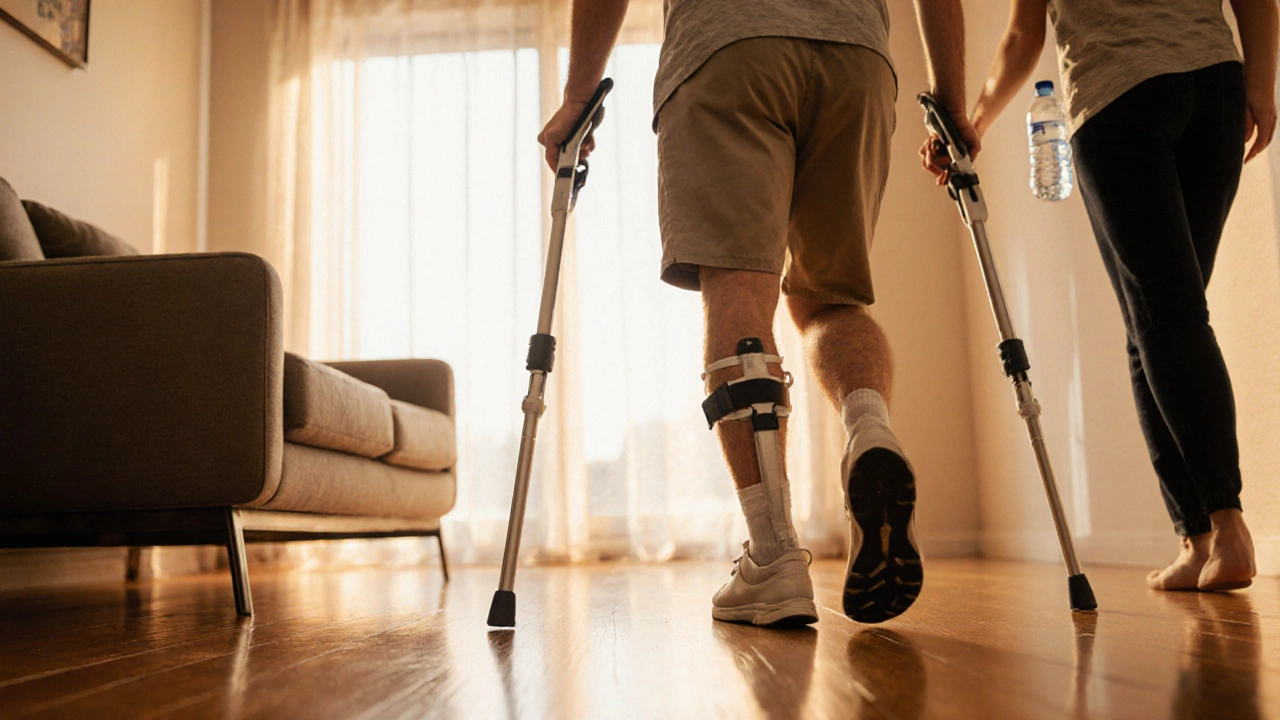Total Knee Replacement Walking Timeline Calculator
Your Personalized Walking Recovery Timeline
Recovery Factors Analysis
Age Factor:
Pre-op Fitness:
Surgical Technique:
Pain Control:
Rehab Adherence:
Personalized Recovery Estimate
Based on your inputs, your estimated recovery timeline is .
This estimate considers your age, fitness level, surgical approach, pain management, and rehab adherence.
After a total knee replacement is a surgical procedure that replaces the worn surfaces of the knee joint with artificial components. many patients wonder, “When will I be able to walk without assistance?” If you're wondering how long it takes to start walking after a total knee replacement, here's the roadmap, the factors that can speed up or slow down the process, and practical tips to make every step count.
Your hospital stay the period you remain admitted after surgery, usually 2‑3 days for a knee replacement typically lasts 2‑3 days, and movement begins almost immediately.
Key Takeaways
- Most patients begin walking with a device (walker or crutches) on day1‑2 after surgery.
- Independent, unaided walking usually appears between 4‑6weeks, depending on individual factors.
- Full, pain‑free walking on varied surfaces often takes 3‑6months.
- Age, pre‑op fitness, pain control, and rehab adherence are the biggest speed influencers.
- Follow a structured rehab plan and watch for warning signs like sudden swelling or severe pain.
Typical Walking Timeline
Here’s a day‑by‑day snapshot based on most orthopedic protocols.
- Day0‑1 (post‑op stay): After the anesthesia wears off, a physical therapist a trained professional who guides movement and exercises helps you sit up, swing your leg, and stand using a walking aid usually a walker or crutches. Expect 5‑10 steps, mainly to the bathroom.
- Day2‑3: You’ll start short hallway walks, 10‑15 meters, still with the aid. The goal is to achieve 20‑30 steps without dizziness.
- Week1‑2: Walking distance increases to about 50‑100 meters. You may transition from a walker to crutches as balance improves.
- Week3‑4: Many surgeons allow you to start using a knee brace a supportive device that limits excessive bending for added confidence. Walking 200‑300 meters without assistive devices becomes realistic for most patients.
- Week5‑6: Independent ambulation on level ground is typical. You can walk 500‑800 meters, climb a few stairs, and resume light house chores.
- Month3: range of motion the degree to which the knee can bend and straighten should be close to 0‑120°, enabling you to walk on uneven surfaces and do longer walks (2‑3km) comfortably.
- Month6‑12: Most patients reach their pre‑surgery walking ability, including jogging or brisk walking, if cleared by the surgeon.

Factors That Influence Walking Speed
Not everyone follows the exact schedule above. Here are the main variables that can shift the timeline.
- Age and overall health: Younger, active individuals tend to regain strength faster. Chronic conditions like diabetes or heart disease can delay healing.
- Pre‑operative fitness: Patients who do “pre‑hab” exercises (strengthening quadriceps and hamstrings) often walk sooner.
- Surgical technique: Minimally invasive approaches cause less tissue trauma, reducing swelling and allowing earlier mobilization.
- Pain management: Effective pain management use of medications, nerve blocks, or cryotherapy to control postoperative pain enables you to move without fear.
- Rehab adherence: Skipping scheduled physical therapy structured rehabilitation sessions led by a therapist or doing exercises at home inconsistently can add weeks to recovery.
- Swelling control: Persistent knee swelling interferes with joint motion and makes walking uncomfortable.
Practical Tips to Speed Up Walking Recovery
These simple habits can shave days or even weeks off your timeline.
- Start moving ASAP: Even tiny leg swings while lying down keep the muscles engaged.
- Use the right aid: A sturdy walker provides stability during the first 48hours. Switch to crutches once you can balance without the walker.
- Follow the therapist’s plan: Consistently perform prescribed exercises-heel slides, quad sets, and ankle pumps-at least three times a day.
- Control swelling: Elevate the leg, apply ice packs for 20minutes every 2hours, and wear compression sleeves if recommended.
- Stay hydrated and eat protein‑rich meals: Nutrition fuels tissue repair.
- Practice safe stairs: Use a railing, step with the operated leg first, and keep the stride small.
- Gradual mileage increase: Add 10‑20meters to your walk each day, but listen to pain cues.
- Wear supportive footwear: Low‑heel shoes with good arch support reduce stress on the knee.

Warning Signs to Watch
Walking is a good sign, but certain symptoms mean you need to call your surgeon or physio right away.
- Sharp, increasing pain that doesn’t improve with medication.
- Rapid swelling, especially if the knee looks red or feels hot.
- Fever above 38°C (100.4°F), indicating possible infection.
- Sudden loss of ability to bear weight or a feeling of “giving way.”
- Bleeding or drainage from the incision site.
Comparison Table: Walking Milestones
| Time Post‑Op | Expected Walking Distance | Typical Aid Used |
|---|---|---|
| Day1‑2 | 5‑10 steps (to bathroom) | Walker |
| Week1 | 50‑100m (short hallway) | Walker → Crutches |
| Week3‑4 | 200‑300m (around house) | Crutches or Knee brace |
| Week5‑6 | 500‑800m (light outdoor stroll) | None or occasional cane |
| Month3 | 2‑3km (steady pace) | None |
Frequently Asked Questions
Can I drive a car after total knee replacement?
Most surgeons clear patients for driving once they can safely operate the pedals for at least 6‑8weeks and have stopped using a walking aid. A quick brake‑response test with a physiotherapist can confirm readiness.
Is it normal to feel pain while walking after the surgery?
Mild aching is common, especially during the first few weeks. Sharp, stabbing pain or pain that worsens after resting signals a problem and should be evaluated.
How many physiotherapy sessions will I need?
A typical protocol includes 2‑3 outpatient sessions per week for the first 6weeks, followed by weekly or bi‑weekly visits up to 3‑4months, plus a home‑exercise program.
Should I use a cane after I stop using crutches?
A cane can provide extra confidence on uneven ground or stairs, but it isn’t mandatory once you can walk unaided for at least 10‑15minutes without pain.
What activities should I avoid for the first six months?
High‑impact sports (running, basketball), deep squats, and kneeling for prolonged periods can stress the implant. Low‑impact activities like swimming, cycling, and brisk walking are usually safe.
Remember, every knee heals at its own pace. Stick to the rehab plan, stay positive, and celebrate each step forward-literally. Before you know it, you’ll be back to your favorite walks, whether that’s a park trail in Bangalore or a stroll around the neighborhood.
